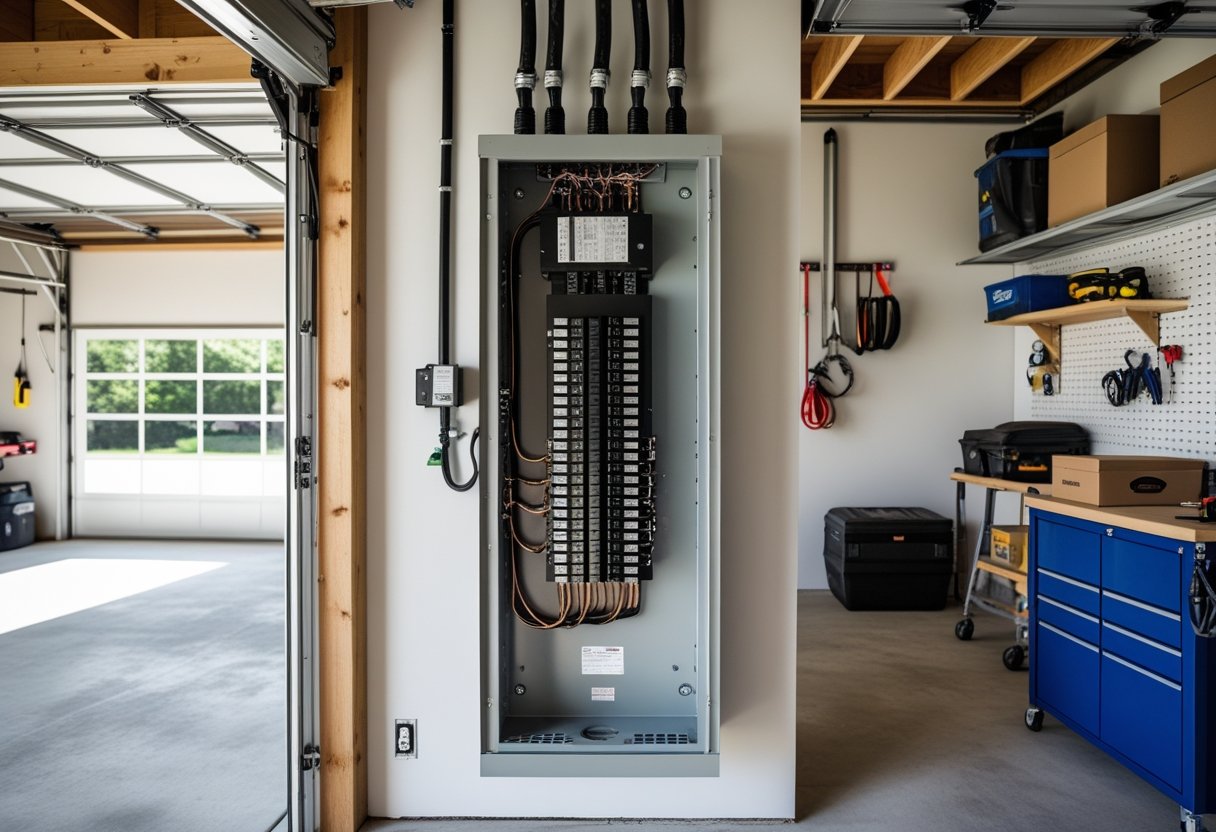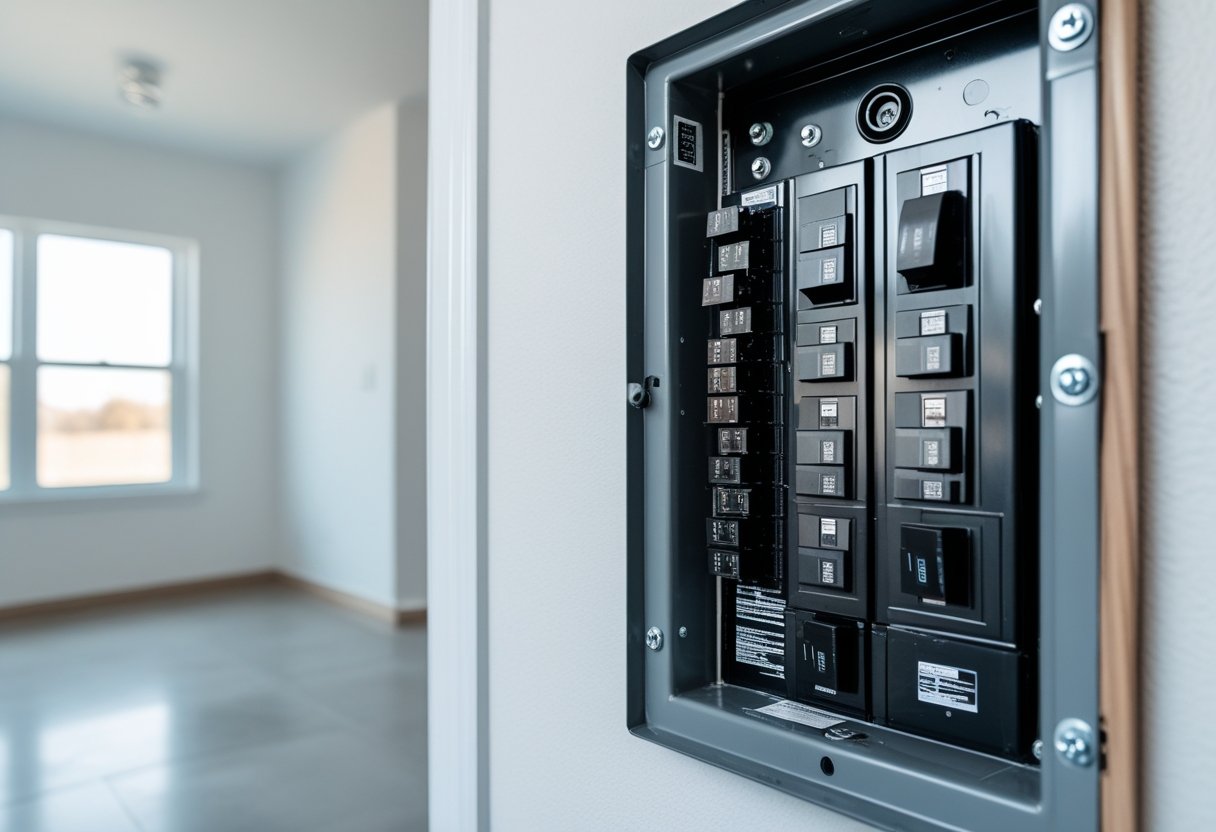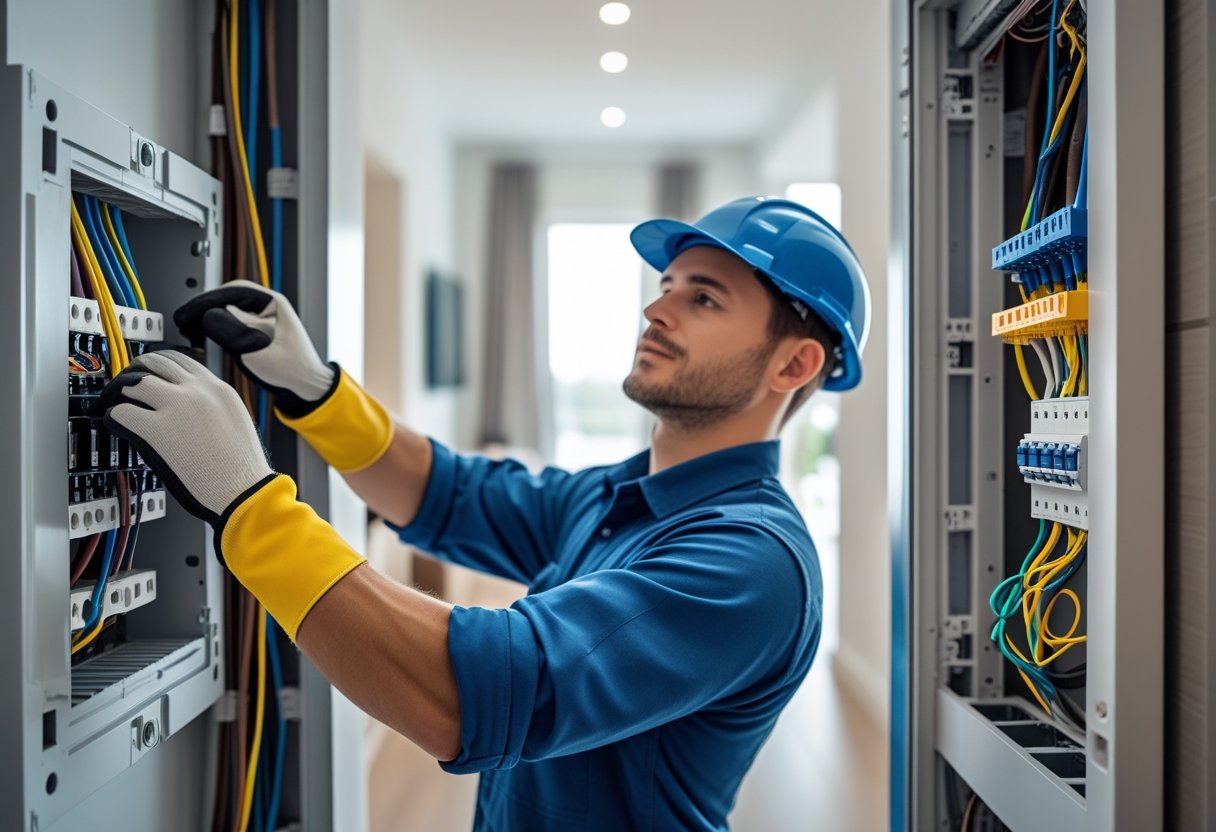If you’re setting up a garage workshop, you might wonder if you need a subpanel to handle all your electrical tools and lighting. A subpanel is usually a good idea when you want to add more circuits or need extra power separate from your main electrical panel.
It helps keep things safe and organized, especially if your workshop uses heavy-duty equipment. Using a subpanel means you won’t overload your main panel, which can cause breakers to trip or even create a fire hazard.
A subpanel also makes it easier to control the power in your garage without affecting the rest of your home. Knowing when to get a subpanel depends on how much power your tools will need and what kind of wiring your garage already has.
Understanding Electrical Subpanels
An electrical subpanel helps manage power in specific areas of your home. It works with your main panel but serves a focused purpose.
Knowing how it works and when to use one can make your garage workshop safer and more efficient.
What Is a Subpanel?
A subpanel is a smaller electrical panel attached to your main panel. It gets power from the main panel and then distributes it to a specific area, like a garage workshop.
Subpanels help control power separately from the rest of your home. You can turn off electricity to the garage without affecting other parts of your house.
They usually have their own circuit breakers and wiring. This setup keeps your workshop’s power needs organized and prevents overloading the main panel.
How Subpanels Differ from Main Panels
The main panel is where power enters your home from the utility company. It controls all the electrical circuits in your house.
A subpanel branches off the main panel and handles only specific circuits. Unlike the main panel, a subpanel doesn’t have a main breaker that controls the whole home.
Instead, it has breakers for just the circuits it serves. Subpanels reduce clutter in your main panel and make adding new circuits easier, especially in spaces like a garage.
Common Uses for Subpanels
You might need a subpanel in your garage if you have many tools or machines that use a lot of power. It’s also helpful if your main panel is too far from your workshop.
Subpanels give you more control over the electricity supply to your workspace. You can safely run heavy tools without tripping breakers for the rest of the house.
They allow you to add circuits easily as your workshop grows. For example, you can install outlets for welders, compressors, or lighting without rewiring your main panel.
Using a subpanel also improves safety by isolating electric loads to just your workshop area. This makes it simpler to troubleshoot or upgrade your garage’s electrical system.
Why You Might Need a Subpanel for a Garage Workshop
Your garage workshop may need extra electrical support to handle power-hungry tools and keep everything safe and organized. Adding a subpanel can help you avoid overloads and make it easier to control your workshop’s electricity.
Power Requirements for Workshop Tools
Many workshop tools require a lot of electricity. Tools like table saws, air compressors, and welders often need dedicated circuits because they use high power.
If you plug too many tools into outlets on your main panel, it can trip breakers or cause flickering lights. A subpanel lets you add more circuits and supply enough power for each tool without overloading the system.
Make sure the subpanel has enough amps to support your tools. Usually, 60 to 100 amps might be needed depending on your equipment.
Managing High Electrical Loads
Some workshop tools run at high loads and can strain a normal home panel. When these tools operate at the same time, the demand for electricity increases a lot.
A subpanel helps by separating the workshop’s electrical load from the rest of your house. It gives you more control over the electricity flow and prevents overloads.
You can also install different breaker sizes in a subpanel to match each tool’s needs. This helps protect your wiring and reduces the chance of trips or shorts.
Improving Safety and Organization
Adding a subpanel keeps your workshop’s electrical system neat and easy to manage. With all circuits related to your workshop in one panel, you can quickly turn power off when working on wiring or making repairs.
A dedicated subpanel also reduces the risk of overheating and electrical faults. By not mixing heavy loads with regular home appliances, you lower the chances of fires or damage.
Organizing your workshop electricity this way makes it easier for electricians to work on your system if needed. It’s a safer and smarter setup for your tools and peace of mind.
Determining If a Subpanel Is Necessary
Knowing if you need a subpanel depends on your current electrical setup, how much power your garage workshop will use, and signs that your existing circuits might be overloaded. Paying attention to these details helps you avoid problems and keeps your workshop safe and efficient.
Assessing Your Current Electrical Capacity
Start by checking your main electrical panel’s size and how much power it can handle. Most homes have panels rated between 100 and 200 amps.
Look for how many circuits you have and how much space is left on your breaker panel. If your panel is almost full or close to max capacity, adding a subpanel is a good idea.
Also, think about the distance from your main panel to the garage. Longer distances might mean voltage drops, which a subpanel installed closer to the garage can help fix.
Identifying Load Calculation Needs
You need to figure out the total power your garage tools and equipment will use. Add up the wattage or amperage for all the devices you plan to run at the same time.
Use this calculation to decide what size subpanel you need. For example, a typical garage workshop might require a 60-100 amp subpanel.
This helps you prevent overloading circuits and ensures your tools have consistent power.
Recognizing Warning Signs of Overloaded Circuits
Watch for flickering lights, outlets that don’t work well, or breakers that trip often. These problems can mean the current electrical setup can’t handle your garage load.
Warm or buzzing outlets and breakers are also warnings that your panel is stressed. If you notice these issues, it’s time to think about installing a subpanel to spread out the electrical demand safely.
Planning for a Garage Workshop Subpanel
To set up a safe and efficient subpanel for your garage workshop, you need to think about how you will use the space, the electrical load you need, and how to handle future upgrades.
Evaluating Your Workshop Layout
Start by looking at your garage’s size and what tools or equipment you plan to use. List all machines, lights, and outlets you will add.
Pay attention to where you want to place heavy tools that need high power. Think about how many circuits you need.
For example, a table saw or air compressor often needs its own circuit. Also, plan for lighting circuits separately.
This stops one issue from shutting down your whole workspace.
Selecting the Right Subpanel Size
Choosing the right subpanel size means knowing your total electrical demand. Calculate the watts your tools and lights will draw at the same time.
Most garage workshop subpanels range from 60 to 100 amps. To pick a subpanel, add up your tool wattages and convert to amps (Amps = Watts ÷ Voltage).
Make sure the panel can handle a bit more than your total needs. This gives you some extra room for safety and surprising power draws.
Future-Proofing Your Electrical System
Think ahead about tools or equipment you might add later. It’s smart to pick a subpanel with extra spaces for breakers.
This avoids rewiring or replacing your panel in the future. Also, consider energy efficiency gadgets or charging stations you may want.
Installing a larger subpanel now saves money and hassle later. Keep in mind that an electrical safety check on your system ensures everything is up to code and protects your workshop from hazards.
Installation Considerations for Garage Subpanels
Before installing a subpanel in your garage, focus on important details like permits, wiring safety, and where to place the panel.
Permits and Local Electrical Codes
You usually need a permit to install a subpanel in your garage. Always check with your local building department before starting.
Permits ensure your installation meets safety and code standards. Local electrical codes vary, so follow the rules for wire size, breaker capacity, and panel type.
Inspectors may require you to use specific materials or install extra safety features. Getting a permit means your work will be inspected.
Inspections protect you from fire risks and electrical failures. If you plan to sell your home later, a permitted job can increase its value.
Wiring and Safety Guidelines
Use the right wire size to avoid overheating and power loss. For most garage subpanels, copper wiring with the correct gauge is needed based on the panel’s amp rating.
You must run a separate grounding wire back to the main panel, along with neutral wires. Neutrals and grounds stay separate in the subpanel to prevent electrical hazards.
Turn off power at the main panel before working. If you’re unsure about any wiring steps, it’s safer to hire a licensed electrician.
Choosing a Suitable Location
Pick a dry, easily accessible spot for your subpanel in the garage. Avoid places exposed to moisture or extreme heat.
Install the panel where it won’t be blocked by tools, vehicles, or storage items. You need clear space for safety and future maintenance.
Mount the panel at about eye level, usually between 4 to 6 feet high. This makes it easier to work on and read the breakers.
Cost and Professional Help
Installing a subpanel in your garage workshop involves specific costs. You also need to know when it’s best to call a licensed electrician to get the job done safely and correctly.
Estimating Subpanel Installation Costs
The cost to install a subpanel depends on several factors. These include the size of the subpanel, the complexity of wiring, and labor fees.
On average, installing a subpanel can cost between $500 and $1,200. Here’s what affects the price:
- Subpanel size: Larger panels cost more.
- Materials: Copper wires and breakers add to the price.
- Labor: Electricians usually charge between $60 and $150 per hour.
- Permits: You may need to get permits from your local authority.
If your subpanel requires upgrading your main panel or adding extra circuits, expect higher costs. Planning ahead and getting quotes can help you stay within your budget.
When to Hire a Licensed Electrician
You should hire a licensed electrician for subpanel installation for safety and code compliance. This work involves handling high voltage and complex wiring, which can be dangerous.
Here are signs you need a pro:
- You lack electrical experience.
- Your home’s wiring is old or complicated.
- The job involves permits or inspections.
- You want the system to meet current safety codes.
A licensed electrician ensures your subpanel works well and prevents possible electrical hazards. They also pull permits when needed and handle inspections, making your installation smoother and safer.
Alternatives to Installing a Subpanel
If adding a subpanel isn’t the right choice for your garage workshop, there are other ways to manage your power needs. You can make changes to your existing circuits or use extension cords correctly to keep things running safely.
Upgrading Existing Circuits
Instead of adding a subpanel, you might improve the circuits you already have. This can mean increasing the capacity of your main panel or replacing old wiring with thicker cables that handle more power.
You could also add dedicated circuits for key tools, ensuring they get enough electricity without overloading your system. This method helps avoid constant breaker trips or dimming lights when using multiple devices.
Keep safety in mind. Upgrades usually require a permit and should be done by a licensed electrician.
They will ensure your system meets local codes and can safely supply your workshop’s power.
Using Extension Cords Safely
Extension cords can be a quick fix, but use them carefully. Choose cords rated for your tools’ power needs.
Avoid thin or cheap cords because they can overheat. Keep cords short and untangled.
Never run cords under rugs or through walls. Use a heavy-duty, grounded extension cord to reduce risks.
Extension cords are not for long-term use. Use them only when necessary and check them regularly for damage.
Maintenance and Long-Term Safety
When you add a subpanel to your garage workshop, keep it well-maintained. Regular checks help you spot problems early.
Look for signs like breakers that trip often or outlets that feel warm. These signs can mean your panel is overloaded or has a loose connection.
If you notice a burning smell near the panel, turn off power and call an electrician right away. Keep the subpanel area clean and dry.
Dust, dirt, and moisture can cause damage over time. Make sure nothing blocks access to the panel so you can reach it quickly in an emergency.
Here’s a quick checklist for safety:
- Check for frequent breaker trips
- Inspect outlets for discoloration or heat
- Keep the panel free of dust and moisture
- Ensure clear access around the panel
- Hire a professional for any repairs
Update or replace your panel if it shows signs of wear or if your power needs increase.
Frequently Asked Questions
Choosing the right size and type of subpanel for your garage workshop depends on your power needs and local rules. Consider breaker size, wiring, and whether your garage meets electrical codes.
What size sub panel is suitable for a typical garage workshop?
A subpanel between 60 and 100 amps usually works well for most garage workshops. This range provides enough power for tools and lighting.
Is a 60 amp sub panel sufficient for garage power needs?
A 60 amp subpanel is often enough for standard power tools and lighting. If you don’t use heavy machinery or many devices at once, 60 amps should cover your needs.
Can I install a sub panel in my garage according to electrical codes?
You can install a subpanel in your garage, but you must follow local electrical codes. This means proper grounding, using the right wire size, and placing the panel in an accessible spot.
What are the wiring requirements for a sub panel in the garage?
You need four-wire feeder cables: two hots, one neutral, and one ground. Separate the ground and neutral in the subpanel to prevent electrical issues.
Do I need a 100 amp sub panel for a large garage workshop?
If you have many power tools or heavy machinery, a 100 amp subpanel is better. It can handle more circuits and higher power loads safely.
How to determine if my attached garage workshop requires a sub panel?
Check the power demands of your tools and appliances. If your main panel is far away or already overloaded, installing a subpanel can help you manage circuits in the garage more easily.





